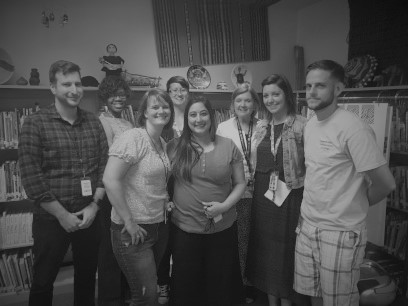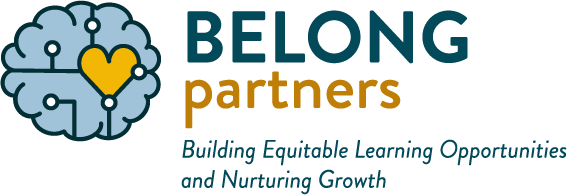Demonstration School Tours
In a normal school year, Demonstration School tours are offered once per month at one of three different schools in the Renton School District:
The tour includes a short presentation, an opportunity to observe an in-progress class meeting, and hear from a panel of students and school staff about the impact that Sound Discipline’s work has had in their school community.
Lakeridge Elementary

Lakeridge Elementary, a Sound Discipline partner school since 2012, appreciates the initiative taken by their data team, made up of staff from all grade levels who meet monthly with Sound Discipline to review discipline data, identify patterns and make recommendations that aim to have an impact on improving the school culture and reduce disciplinary problems.
At the end of the 2019 school year, the Lakeridge Elementary data team discussed making disproportionality something the whole school could understand and buy into its importance. The data team chose to use the term, “disproportionality” because that is how the discipline data shows up. As school discipline data teams become skilled, they are able to directly address the data that shows that students of color are disciplined at higher rates than their white peers.
With the start of the 2020-2021 year, the whole school is focused on disproportionality and how to operationalize the work. Led by multiple stakeholders and using the class meeting format to identify problems and figure out solutions, one teacher shares their specific problem, and the rest of the people in the meeting offer solutions. At the end of the discussion, the teacher who originally shared the problem, chooses one solution to try out that week. Using this class meeting process, anti-racist work is now a school-wide priority. There is an air of hope and excitement in the school community. It’s a work in progress — and the whole school is very committed.
We’re not gonna stop this work because it’s messy and we’re not gonna try to be perfect. We’re gonna be in the mess and keep on figuring it out as we go.
Assistant Principal
Lakeridge has three different teams working on anti-racism: 1) the data team, 2) an anti-racist process team, and 3) a SEL team. All three teams are working together to consider changes such as making ethnic studies a part of everyday school life.
The principal said, “I have never seen this many people ready for change at the same time.” Another school leadership spokesperson added, “this is totally non-negotiable. We need to be exploring our relationship to racism and how it shows up individually and as a system in the school.”
It’s been amazing for Alan Wong, Sound Discipline’s facilitator, to see the Lakeridge Elementary school community doing this work to build authentic community, develop youth leadership, and advocate for anti-racist practices within schools.
Feedback from a school tour attendee at Lakeridge:
Thank you for fitting our four staff members into the school tour of Lakeridge Elementary today. WOW, did they come back fired up! I see hope all over them. Thank you again. We are so excited to work with Sound Discipline and have the support and guidance we need to create a safe, positive learning environment for ALL of our students.
Program Specialist, local school district
Honey Dew Elementary

Honey Dew Elementary, a Sound Discipline school partner since 2016, began implementing the Whole School Model their first year. The Whole School model includes having every classroom hold class meetings three times a week to solve problems, learn social skills, and build community. A primary tenet of a class meeting is to share the leadership responsibilities.
Henry, a 4th-grade student, added to the class meeting agenda his concern about teasing on the bus. When it was his turn to speak, he shared that boys on the bus teased him about being gay. Henry said he wanted to share his feelings while others listened, which is one of the problem-solving choices at a class meeting. Henry shared that he didn’t know if he was gay or not, but the teasing bugged him. The class was silent. Boys on either side of Henry put their arms on Henry’s shoulder. The class listened respectfully. At the next class meeting, Henry reported back: yes, there was still some teasing. However, now it didn’t bother him as much because he knew his whole class “had his back.” Sound Discipline facilitators appreciated how the class meeting environment was safe enough for Henry to share his concerns and how he felt different, knowing he was not alone.
Monthly school-wide class meetings also take place with student representatives from each classroom. The representatives sit in a circle and use the class meeting structure to share ideas from their classrooms and then bring the larger group’s decisions back to their class. This model elevates each student’s voice. One example of an action step brought up at a monthly school-wide class meeting was to review and revise school-wide hallway expectations.
Feedback from a school tour attendee at Honey Dew:
I just got back from the Sound Discipline tour of Honey Dew Elementary. This aligns closely with my personal area of interest on childhood trauma & recovery, and I am totally blown away and inspired by what I saw today. I would love to see SD expand further into the community and beyond. After experiencing the tour, I believe this model should be the standard all across the board, for every school.
Jennifer Morrissey, Renton parent
Bryn Mawr Elementary

Sound Discipline has been working with Bryn Mawr Elementary since 2015. Like Lakeridge and Honey Dew, every classroom at Bryn Mawr Elementary holds class meetings three times a week to solve problems and build community. Principal Jaime Maxie and her staff have created an environment where staff and students work together to develop creative solutions to discipline issues.
For example, educators discussed the importance of self-regulation and recognized that some students needed a safe place to cool down outside on the playground. They designed moving “cool-down zones” so students could find a staff member and quietly walk alongside them to self-regulate. After trying this, they realized it wasn’t doing what they wanted. They brainstormed how they could replicate the structure students use successfully inside in their classrooms – outside the classroom – and they came up with the idea of painting “cool down clouds” on the playground to serve as places to pause to re-regulate. Over time, their attention to building skills intentionally helped make spaces safe for students on the playground.
